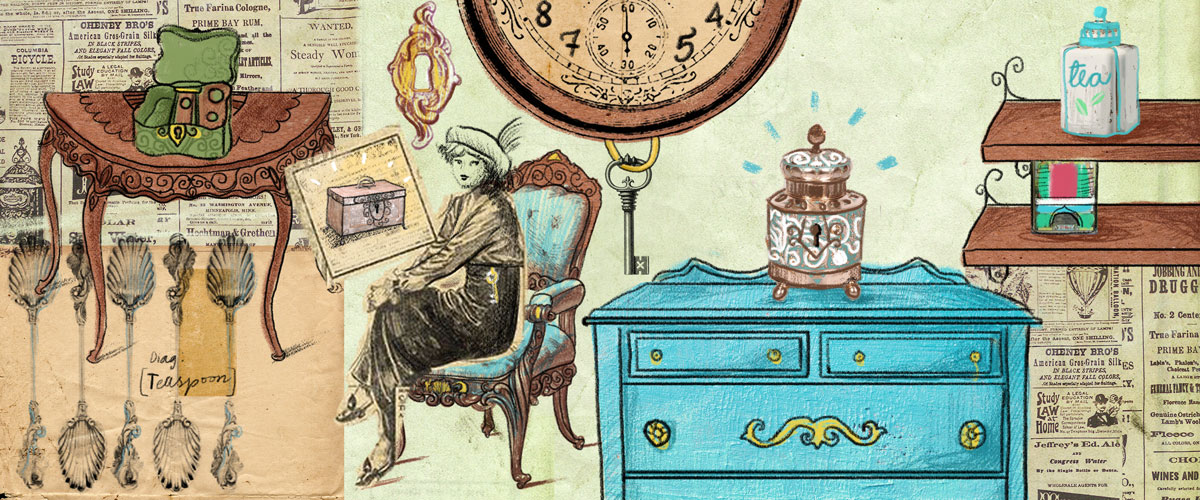Losing your keys is a major disruption. The car, house, office and of course your tea container. You do lock up your tea bags, surely? And you carry the key with you everywhere and never leave it lying around?
The questions sound silly now but from the 17th to early 19th century in Britain and the US, the answers would have been “Well, of course.” The lady of a house – both doyenne and dwelling would be upper class because one pound of tea cost 3-6 months of the average wages of the household workers – guarded the tea very carefully, carrying the key to the tea caddy around her waist, and storing it when not needed in a safe hideaway in her bedroom.
“Caddy” comes from the China-Malay word “kati,” an originally wooden chest that held just over one pound of tea. In the 1760s-1820s caddies were beautiful, expensive and status-signaling showpieces. The variety was immense.

The materials range from lacquered wood, to silver, tortoiseshell, exotic solid woods and veneers, brass, paper lacrame overlays (a specialty of French prisoners of war in the Napoleonic period) ivory and even paper mache strengthened by clay. While tea sets were porcelain and bone china, caddies needed less fragile construction. Designs were tasteful, artistic, fashionable, flamboyant, in-your-face exhibitionist, and functional.
Caddies had just one feature in common: the key hole. Can you think of any other tableware, food containers, or pots and pans with this as central to their design?
When your tea costs the modern equivalent of several thousand dollars a pound, you keep it protected. When it’s something everyone wants, you make this a priority. One need was to prevent pilfering by the maid servants. Another was to ensure it was not wasted but served carefully and in sight of the lady of the house.
The used tea – “slops” – was generally given to the servants and they in turn often sold it off locally, adulterated with cow manure. As tea dropped in price and the massive taxes, as high as 114%, were cut to single digits, tea allowances became an equivalent of health insurance as part of employment benefits. Tea was that important.
And as with your smartphone, it created a market for add-ons and accessories, such as the spoon that provided a precise measure for scooping the leaf into the (silver) teapot. Precision mattered at $50 or so a brew. So, yes, this is exactly how the “teaspoon” became a general unit of measurement across all foods and cooking.
Tables for supporting and moving the caddy became elaborate and elegant. Tea strainers added artistic design to functional simplicity. The early caddies held just green tea, the “hyson” that was the only import from China. Adulteration and such chemical enhancements as poisonous cobalt blue to add a bright shine to the leaf made helped shift taste “red” bohea tea – basic black. Caddies had two compartments, often marked “H” and “B.”

The caddy lived on as a storage container but the key disappeared by mid-Victorian times and modern ones became simple storage boxes. How you store your tea remains very important. Never in the refrigerator. Never in a box or package that allows light, heat and odors to get absorbed by the chemically dynamic leaf. Always tightly sealed, preferably with an inner and outer lid.
But you can throw away the key.
Featured illustration by Tasneem Amiruddin


1 Comment
Seeing the origin of the word caddy reminded me of the weight measurement – catty or kati – that I used to come across in eastern tales (I’m sure it was in the Arabian Nights at least). So I looked it up on Wikipedia to discover that it is an actual weight measurement and is, apparently, approximately one and third pounds avoirdupois. I’m now wondering, did the kati (chest) give rise to the measurement or the other way around? Seems too much of a coincidence but, of course, I don’t have the actual spelling in Chinese to be able to compare.